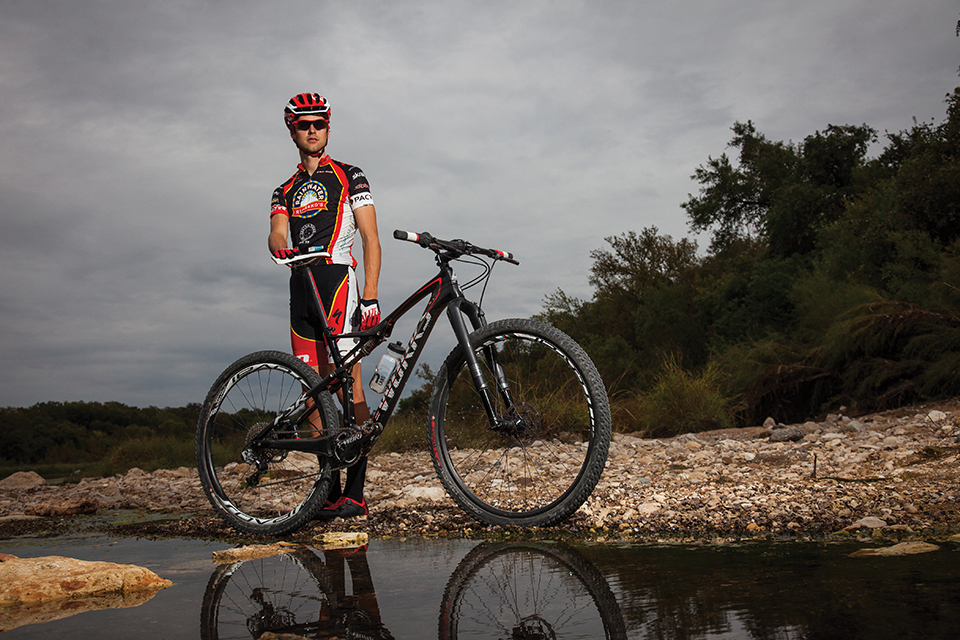What to Expect at a Mountain Bike Skills Clinic

Crooked helmet, sleeveless jersey, aluminum bike; I was certainly a candidate for a “first-time racers clinic.” Despite my teenage pride, I attended the free day-before class at my first Texas Mountain Bike Racing Association series event in Comfort, Texas. And it was one of the best decisions I could have made. Put on by one of the local grassroots mountain biking teams, eight of us were walked through the basics of bike set up, race strategy, and fueling techniques. Fast forward eight years, and I’m now a professional mountain bike racer who hosts his own clinics through Williams Racing Academy in Wimberley. So who, you ask, should attend a mountain bike skills—or first-time racer—clinic? My answer to that: Everybody.
The first skills clinic I ever taught drew a crowd of mountain bikers ranging from regional pro-level riders to individuals more interested in having some fun on the trail. Registration was capped at 12 riders since smaller groups allow for a much more fulfilling and effective hands-on experience. Here is what a typical weekend at a clinic consists of:
Day One (Saturday)
Today is all about laying down (or updating) the foundation of basic skills. Even nearing my tenth season as racer, I always go back and practice the fundamentals of bike handling during the offseason. Typically the first session begins shortly after lunch (included), allowing out-of-towners a chance to make the trip. We spend all afternoon riding in a big grassy field. (Yes, this is still a mountain bike clinic, not cyclocross.) With the help of a few props, this is where we lay the groundwork for tackling the gnarliest of singletrack.
Some of the skills we focus on, and how we work to improve them are:
Bike set up: Some riders show up with $12,000 bikes, and others with $600 bikes, but even the most space-age race rig is going to perform poorly if it’s not set up correctly. I like to spend a few minutes with each rider and their steed before we start riding. Sometimes lowering the saddle just five millimeters, or rotating the brake levers down just a touch can transform a rider’s comfort and confidence level.
Braking: Learning to slow down properly is key to going faster. By teaching body position, timing, finesse, and a few flashier tricks, this is one of the areas I see the most improvement in over the course of a weekend. On Saturday, we accomplish this through cone drills and basic obstacle courses. On Sunday, we take those skills to the trail—to the ever-changing puzzle of singletrack.
Cornering: When discussing race courses, competitors can almost always be heard conferring about “the gnarly rock garden,” or “that off-camber root section.” However, the biggest place time in a race is—excluding climbs—won and lost in the corners. So how do we work on getting better at turning? It starts in our grassy field of dreams with a bunch of orange cones. With cornering, we work to combine body position, balance, and braking to maintain the most speed and momentum.
Balance: Once we learn to ride a bike, balancing on it becomes second nature. But what about when you come up on a slow-speed jumble of rocks, or tough Texas Hill Country ledge? Confidence at low speeds is critical to conquering that challenging bit you still haven’t cleaned. We work on this through track stand practice, close-quarter obstacle courses, and friendly games of “foot down” (basically neck-friendly bumper cars on bikes).
Vertical agility: Being able to hop up, jump, and roll down obstacles is critical to most trails, especially in the Austin area. These skills are more advanced, but breaking them down into their components in the safety of a grass field allows for a progressive approach that builds confidence. By using logs, stacked wooden boxes, and other methods, this is one of the most fulfilling parts of the weekend for participants.
Day Two (Sunday)
While Saturday afternoon was all about the grass field, Sunday is all about the trail. We take the skills learned the day before, and apply them as we go for a singletrack ride together. Undoubtedly, springing up a rock ledge with loose dirt on the run up and trees hugging in feels very different than the wooden box in the grass field. However, the fundamentals are the same. We stop at different features—discussing, tweaking, and refining. At the end of the day, riding single-track efficiently and quickly is all about the conservation of momentum, accomplished by putting all these skills together.
By signing up for a mountain bike skills clinic, what would take you two months of practice on your own you can improve over the course of two days. Plus, it’s fun, social, and for about the cost of a weekend of racing, you can be at a completely new riding level the next time you want to put the drop on your friends.






